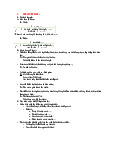


Preview text:
1. Introduction
Purpose of the Study: Explain the aim of your research and why
studying the marketing strategy of the chosen company is important.
Background Information: Provide a brief overview of the company,
including its history, mission, vision, and current market position.
Scope of the Study: Outline the main areas you will cover in your analysis. 2. Literature Review
Marketing Strategy: Define what a marketing strategy is and explain its importance for businesses.
Components of Marketing Strategy: Describe the key components,
including market research, target market identification, positioning,
and the marketing mix (4 Ps: Product, Price, Place, Promotion).
Theoretical Frameworks: Discuss relevant theories and models,
such as SWOT analysis, Porter’s Five Forces, and the Marketing Mix Model. 3. Research Methodology
Research Design: Explain the approach you will take (qualitative,
quantitative, or mixed methods).
Data Collection Methods: Describe how you will gather data (e.g.,
surveys, interviews, secondary data analysis).
Data Analysis Techniques: Outline how you will analyze the data collected. 4. Company Overview
Company Background: Detailed history and evolution of the company.
Product/Service Offerings: Describe the company's main products or services.
Market Position: Current standing of the company in the market,
including market share and competitive landscape.
5. Analysis of Marketing Strategy
Market Research: Discuss how the company conducts market
research and gathers consumer insights.
Target Market: Define the company's target market and explain the segmentation criteria used.
Positioning: Explain the positioning strategy of the company and how
it differentiates itself from competitors. Marketing Mix (4 Ps):
Product: Analysis of the product strategy, including product
lines, features, and lifecycle.
Price: Pricing strategies used by the company and how they
align with market conditions and consumer expectations.
Place (Distribution): Distribution channels and logistics strategies.
Promotion: Promotional strategies, including advertising, sales
promotions, public relations, and digital marketing.
6. Case Study: Marketing Strategy of Cholimex Food (2020-2022)
Strategic Goals: Discuss the specific marketing goals set by Cholimex Food during this period.
Implementation of Marketing Mix: How Cholimex Food utilized the
4 Ps to achieve its marketing objectives.
Digital Marketing and Innovation: Role of digital marketing and
any innovative approaches taken.
Outcomes and Performance: Analyze the outcomes of the
strategies and their impact on the company’s performance.
7. Evaluation and Recommendations
Strengths and Weaknesses: Evaluate the strengths and
weaknesses of the company's marketing strategy.
Opportunities and Threats: Identify potential opportunities and
threats in the market environment.
Recommendations: Provide actionable recommendations for
improving the company’s marketing strategy. 8. Conclusion
Summary of Findings: Recap the main findings from your analysis.
Implications for Practice: Discuss the practical implications of your
research for the company and the industry.
Future Research: Suggest areas for future research on the topic. 9. References
Citations: List all the sources you have cited in your thesis, formatted
according to the appropriate academic style guide (e.g., APA, MLA).
Key Definitions and Concepts
Marketing Strategy: A long-term approach to planning with the
fundamental goal of achieving a sustainable competitive advantage.
Market Research: The process of gathering, analyzing, and
interpreting information about a market.
Target Market: A specific group of consumers at which a company
aims its products and services.
Positioning: The process of establishing an image or identity for a
product or brand in the consumer’s mind.
Marketing Mix (4 Ps): The set of actions or tactics that a company
uses to promote its brand or product in the market.
Sources for Further Reading
Kotler, P., & Keller, K. L. (2016). (15th ed.). Pearson. Porter, M. E. (2008). . Free Press.
Li, H., Green, R., & Montgomery, C. (2021).
. Journal of Business Research.
Using these sections and concepts, you can build a comprehensive and well-
structured thesis on the marketing strategy of a company.




